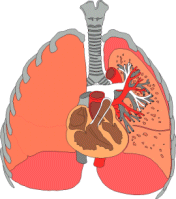|
Equipment |
|
|
One of the advantages of incentive spirometry is its relative simplicity and low cost of the equipment. Although recent advances in technology have made available some very sophisticated approaches, there is no evidence that these devices produce any better outcomes than their lower cost, disposable counterparts.
|
There is actually no clinical evidence that equipment of any sort is needed to achieve the goals of IS. With cooperative patients, the traditional prescription to "deep breath and cough," if aggressively followed, may well be as effective as the use of a given IS device.
However, the use of IS equipment as a substitute for this traditional regimen has a sound practical basis:
- IS equipment helps in setting and monitoring progress toward measurable
goals, thereby providing some degree of patient motivation (the incentive
portion of incentive spirometry).
- Once a patient is properly instructed in the method, the treatment regimen can be conducted without direct supervision, thus making this approach more cost-effective than the one-on-one intervention otherwise required.
IS devices can generally be categorized as either volume or flow-oriented. Volume-oriented devices actually measure and visually indicate the volume achieved during the SMI. Flow-oriented devices, on the other hand, measure and visually indicate inspiratory flow. This flow is equated with volume by assessing the duration of inspiration or time (flow X time = volume):
- Volume-Oriented Devices. A typical volume-oriented disposable
IS device is a true volume displacement incentive spirometer. A corrugated
large-bore breathing hose and mouthpiece connect the patient to a flexible
plastic bellows. During inspiration, as the patient draws air through
the breathing hose, the bellows rises, An indicator on the device enclosure
indicates the vlumetric displacement. Once it reaches its maximum displacement
for a given breath, the patient is told to hold the bellows in place
for 5 to 10 seconds (the end-inspiratory hold). After completion of
the maneuver, the patient removes the mouthpiece, allowing gravity to
return the bellows to its initial starting position.
- Flow-Oriented Devices. While volume-oriented IS devices actually
measure volume, flow-oriented devices provide only an indirect indicator
of the patient's inspired volume. Typically, this is achieved with calibrated
flow indicators which function on the same principle as a Thorpe-tube
flowmeter.
In a flow-oriented IS device, ping-pong like balls are enclosed in three connected plastic flow tubes. As the patient inhales through the mouthpiece, Pressure drops and causes the ball in the first tube to rise to a level equivalent to the flow around it. Each tube is calibrated such that full displacement of its ball equals a specific flow, as indicated on the wall of the tube.
As flow exceeds the maximum for the first tube, the ball in the second tube rises, followed by that in the third tube. To maintain an end-inspiratory hold with this type of device, the patient is instructed to keep the indicator balls elevated to full displacement for as long as possible.
Inspired volume is estimated as the product inspired flow times time:
V (liters) = V (cc/sec) X time (sec)1000
For example, if a patient were to maintain displacement of the balls in the first and second chamber of this device for 3 seconds, the estimated inspired volume would be calculated as:
V (liters) = [900 cc/sec x 3 sec]1000V (liters) = 2.7 liters
Obviously, given the relative imprecision of such devices and the errors inherent in the bedside measurement of these short-time intervals, volume measurements derived from flow-oriented incentive spirometers should be treated only as rough estimates of actual inspired volume. To overcome this problem, many manufacturers now provide hybrid IS devices that are flow-oriented, but include a relatively accurate volume accumulator.
Since there is no conclusive evidence to support the use of one type or brand of IS device over others, the decision as to which equipment is best currently must be based on empirical assessment of patient acceptance, ease of use, and cost.
